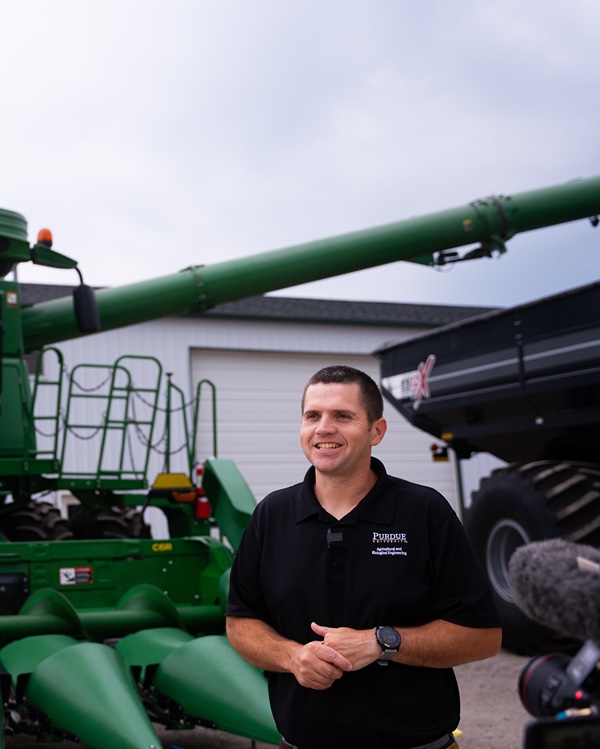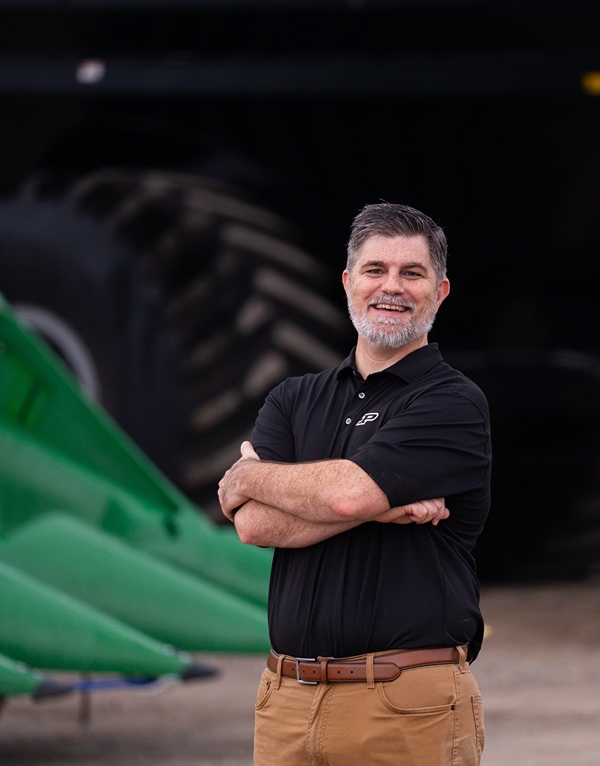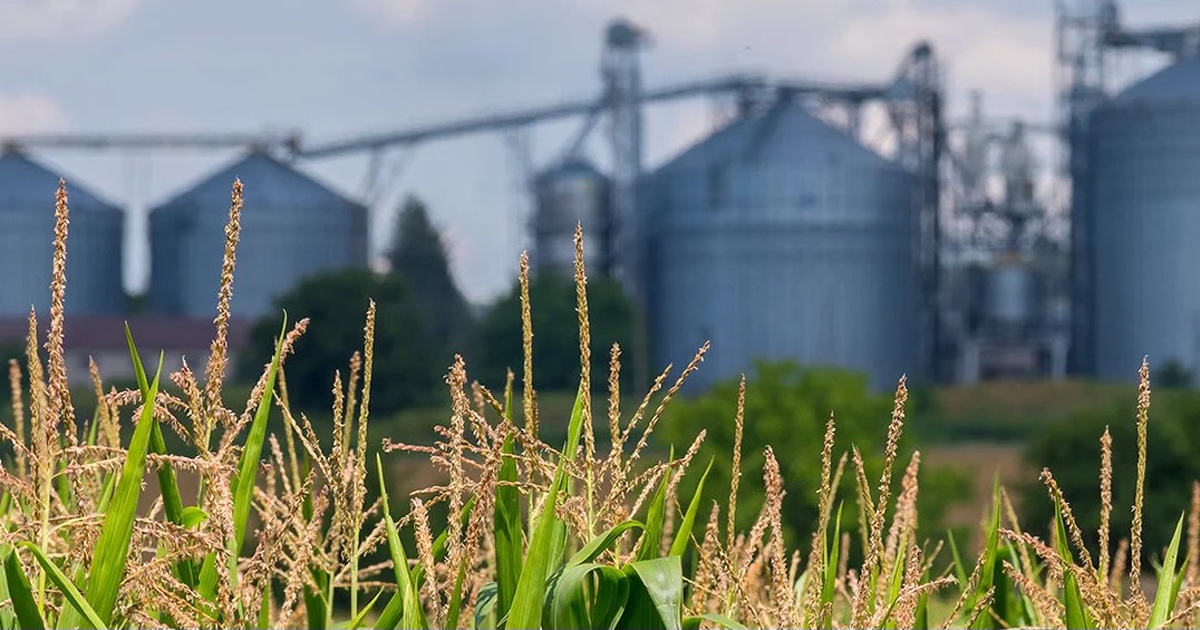Harvesting in sync: Purdue and John Deere develop automated unloading technology
Harvest is one of the most demanding times in a farmer’s year. The clock is always ticking, and every grain spilled or minute wasted equals profit lost.
One of the most intricate maneuvers on the field is unloading grain from a combine into a grain cart while both vehicles are moving. It’s a task that requires near-perfect synchronization between the combine operator and the tractor driver pulling the grain cart.
That same kind of close collaboration recently played out in a project between Purdue University and John Deere. Combining industry experience with research expertise, the two organizations developed an initial demonstration of Auto Unload, a precision technology that improves productivity, reduces operator fatigue, and saves valuable time during harvest.
It’s a partnership that mirrors the technology itself: two parts moving in sync toward a shared goal.
During harvest, efficiency is everything. Unloading grain on the go can improve combine productivity by as much as 23 percent, but it’s a complicated procedure that demands tight focus and coordination between the combine and tractor operators again and again.
“It’s like landing an aircraft,” explained Corwin Puryk, staff engineer and John Deere’s principal investigator for the project. “Farmers face intense pressure to align the machines with precision – sometimes up to ten times per hour over a twelve-hour workday.”
John Deere’s existing Machine Sync system already offered a partial solution to keep the vehicles aligned during unloading. But it still required constant attention and manual adjustments from the combine operator to distribute grain evenly across the cart.
Purdue University and John Deere had been discussing opportunities to collaborate, and the development of an automated unloading system was the perfect chance to combine forces. Purdue didn’t just have technical expertise – the university also offered agricultural insight and the facilities to test emerging technologies in real-world conditions.
“We really see Purdue as one of the leading universities to look to in agriculture,” said Jennifer Preston, vice president at John Deere Electric Powertrain and CEO of Kriesel Electric. Her own Boilermaker ties run deep – she holds a degree in electrical engineering from Purdue and serves as the Executive Focal from John Deere to Purdue.
Where John Deere’s engineers brought practical insights from the field and a track record of building dependable machinery, Purdue contributed deep agricultural roots, broad technical knowledge, and access to a perfect test site at the Agronomy Center for Research and Education (ACRE).
Industry Partnerships at Purdue University
“Purdue and John Deere have a long history and this is a great example of what we can do together,” explained Eric Woods, Executive Director of Industry Partnerships at Purdue University. “They came to us with a complex problem, and we had the research capabilities to find a solution.”
“Purdue and John Deere have a long history and this is a great example of what we can do together,” explained Eric Woods, Executive Director of Industry Partnerships at Purdue University. “They came to us with a complex problem, and we had the research capabilities to find a solution.”
Greg Shaver, professor of mechanical engineering and the director of Herrick Labs, served as the university’s principal investigator. He assembled a team of faculty and students across disciplines: Aerospace Engineering, Agricultural and Biological Engineering (ABE), Agronomy, and Mechanical Engineering.
Shaver’s expertise in vehicle automation was complemented by John Evans, assistant professor of agricultural and biological engineering, who contributed firsthand farming experience as well as a background in agriculture robotics. Mechanical engineering PhD candidates Ziping Liu, Chufan Jiang and Shveta Dhamankar also played a significant role in creating the automation system models and algorithms.
“I knew going in that Purdue could help,” Shaver said. “This was a challenging, unique opportunity to work with John Deere on a multi-year effort – and, ultimately, it was successful.”
Much like the machines themselves, the people behind the project had to work in tandem. Shaver and Evans, together with Purdue colleagues Daniel DeLaurentis and Tony Vyn, guided graduate and PhD students in developing and testing the technology.
At John Deere, the efforts were equally cross-departmental. Puryk, an engineer in Crop Harvesting Advanced Engineering, worked closely with Ryan White, Brandon McDonald and other colleagues in the Intelligent Solutions Group to ensure Purdue’s upgrades were compatible with existing hardware.
“I was impressed by the caliber of work and breath of fresh air Purdue brought to the project,” noted Puryk. “The students were always eager, full of questions, and willing to learn.”
Working together, they tackled challenges one by one: overcoming visibility issues caused by dust, light and weather; maintaining alignment over uneven terrain; detecting fill levels in the grain cart to maximize each load.
The auto unload system was built on John Deere’s Machine Sync and Machine Vision technology, using sophisticated algorithms to automatically measure the amount of grain and autonomously move the cart to evenly distribute the load. Extensive testing in the ACRE fields proved its viability.
After two years of development, Purdue delivered a working prototype at the end of 2020. A variant of the vehicle automated unloading system was officially granted a U.S. patent in 2023 and a fully integrated solution with the latest hardware architecture will be available to customers as a John Deere Precision Upgrade beginning in late 2025 and as a factory option in 2026.
But the bigger achievement was the partnership itself – one that benefited John Deere, Purdue and, most importantly, the farmers who stand to gain from the technology.
“Seeing this have an impact on farmers is one of my proudest achievements,” said Evans. “They have enough on their plate already. This takes one more thing off their hands.”
For John Deere, the project reaffirmed the value of working closely with a university partner who brought fresh ideas and cutting-edge research capabilities. For Purdue, it gave students hands-on experience solving real problems facing modern farmers, from theory to implementation.
“We’re delighted to have made a positive impact on John Deere and its customers,” Shaver added. “Having the work we do with our students and industry partners implemented in the real world is the ultimate satisfaction.”
A productive harvest is built on timing, trust, and teamwork – and so is a successful relationship between industry and university partners.
“With our strategic alliance, John Deere and Purdue are able to accomplish more than either organization could alone,” said Woods. “This project was another step towards our shared goal: to help the feed the planet and change people’s lives.”
As labor, scale, and budget demands on agriculture continue to rise, developing new technologies to ease the pressure on farmers will be increasingly important. It’s a challenge the engineers and researchers at Purdue and John Deere are eager to take on.
Collaboration between the two organizations opened the doors for an automated solution that makes one of the most complicated harvest tasks more efficient, reliable, and less stressful for the people behind the wheel.
“There’s more grain harvested. There’s less grain on the ground. And when the farmer goes home at the end of the day, they’re going to be happier and less exhausted,” Shaver explained.
It’s an example of how Purdue University excels at working with industry partners to develop novel solutions to practical problems – while helping ensure the people feeding the world have the tools they need to succeed.
John Deere Day
John Deere Day at Purdue University will be held September 8, 2025 from 9 a.m. to 4 p.m. at the Engineering Fountain and the Ag Admin (AGAD) lawn. Each location will have equipment, displays, virtual reality simulators, giveaways, prizes and employees ready to answer questions and talk about their experiences.
Learn More







